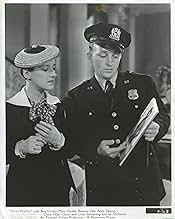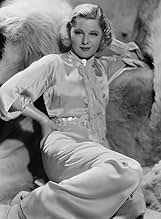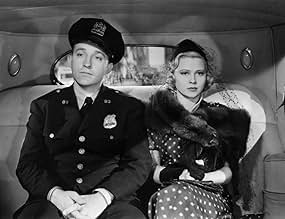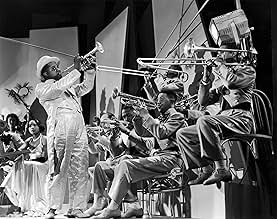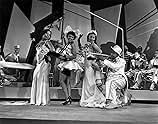Dr. Bill Remsen pretends to be a policeman, and ends up being assigned to guard Judy Marlowe. Amazingly, he falls in love with her.Dr. Bill Remsen pretends to be a policeman, and ends up being assigned to guard Judy Marlowe. Amazingly, he falls in love with her.Dr. Bill Remsen pretends to be a policeman, and ends up being assigned to guard Judy Marlowe. Amazingly, he falls in love with her.
- Awards
- 3 wins total
Featured reviews
My wife and I saw Dr. Rhythm when we were first married about 40 years ago. We loved it and never forgot the main song, nor Beatricy Lillie driving Franklin Pangborn crazy over the danner nipkins. For the last 20 years or so we've tried unsuccessfully to get a copy. Turner doesn't even list it. Other posters here also remember it fondly, hoping to see it again. Good news! As of January 2013 the entire film is posted on YouTube. We just watched it and it was as good as we remembered. The songs are pleasant, the actors are old favorites, including Andy Devine and Sterling Holloway. The action is unexpected and well paced. The comedy is unforced and genuine. Bea Lillie steals the show whenever she appears. Indeed, she should have received equal billing with Crosby. Why not? Only a gypsy knows!
Hi I've been looking for a copy of this film for some time. If anyone has one please contact me. In addition to the classic double damask napkin scene there is a very funny dentist scene with Bea Lillie and Andy Devine.
Joe Higgins
Joe Higgins
The film starts out slow, but jumps to full speed whenever Bea Lillie is on screen. Mostly just a jumble of tedious situation comedy bumbling, the film is saved by Ms. Lillie's musical numbers and her "double-damask dinner napkin" routine with Franklin Pangborn.
7tavm
After years of knowing this obscure Bing Crosby movie was on YouTube, I finally decided to watch this just now there. The story is quite a mess concerning Crosby's doctor character switching places with Andy Devine's policeman for reasons I don't feel like revealing here. Also appearing is legendary British stage comedienne Bea Lillie who does her "dinner napkins" routine to hilarious effect with Franklin Pangborn and a few others. She also has another funny one with Devine as the doctor and one with Crosby near the end. She also performs some funny numbers sans Crosby who does his usual love songs to nice effect. In summary, Doctor Rhythm was a funny musical comedy but don't expect it to make too much sense if you want to enjoy it to its fullest...
"Doctor Rhythm" (Paramount, 1938), directed by Frank Tuttle, based upon a story, "The Badge of Policeman O'Roon" by O. Henry, is a lightweight musical-comedy starring Bing Crosby, a movie that seems to be best remembered today solely for its "Double Dasmisk Dinner Napkins" routine featuring none other than comedienne Beatrice Lillie (1894-1989) in a very rare screen appearance during Hollywood's Golden Age. And she is not only very funny, but a bizarre personality who seems to be an unlikely performer to be featured in a Bing Crosby musical.
The story opens at Central Park when four alumni of Public School 43 of Brooklyn, N.Y., meet at midnight (?) for their annual reunion. The four men are Luke (Sterling Holloway), an ice cream salesman; Al (Rufe Davis), a zoo keeper; Larry O'Roon (Andy Devine), a policeman; and Doctor William Remsen (Bing Crosby), getting together, and singing the film's first tune, "P.S. 43." Because O'Roon gets nice and drunk and is unable to go on duty the following morning, Remsen decides to take his place for the day, assuming the assignment as a bodyguard to a spoiled heiress named Judy Marlowe (Mary Carlisle), engaged to a phony, Chris LeRoy (Fred Keating) who not only has a questionable past, but is only after her money. Of course, she's unaware of his scheme. After a love-hate relationship between Remsen and Judy, the thin storyline concludes with a policeman's benefit supported by Lorelei Dodge-Blodgett (Bea Lillie) who not only MC's on stage wearing roller skates, but performs in an opera burlesque number titled "Only a Gypsy Knows."
Other songs by Johnny Burke and Jimmy Monaco include: "My Heart is Taking Lessons" (sung by Crosby); "Rhythm" (sung by Bea Lillie); "On the Sentimental Side" "On the Sentimental Side" (reprise); "My Heart is Taking Lessons," "This Is My Night to Dream" (this nice sentimental tune sung by Crosby to Carlisle in the tunnel of love sequence); and "My Heart is Taking Lessons" (sung by Crosby and cast). Although I find many of the songs quite listenable, they are virtually forgotten today.
The supporting players include Franklin Pangborn and William Austin, character actors who partake in the "Double Dasmisk Dinner Napkins" routine; Laura Hope Crews, John Hamilton (the one and only Perry White of the "Superman" TV series of the 1950s) and Henry Wadsworth as Otis. As for blonde and pert Mary Carlisle, she makes her third and final appearance opposite Crosby.
Like many other musicals of the 1930s, "Doctor Rhythm" is just an excuse to have Bing Crosby going through 80 minutes or so of silly plot and introducing several tunes with a songwriter's hope that one of them will end up on the Hit Parade charts before rapping it all up in the end. While no masterpiece, "Doctor Rhythm" is a real curio, and a film's buff's dream to have it resurface again on television or video. (***)
The story opens at Central Park when four alumni of Public School 43 of Brooklyn, N.Y., meet at midnight (?) for their annual reunion. The four men are Luke (Sterling Holloway), an ice cream salesman; Al (Rufe Davis), a zoo keeper; Larry O'Roon (Andy Devine), a policeman; and Doctor William Remsen (Bing Crosby), getting together, and singing the film's first tune, "P.S. 43." Because O'Roon gets nice and drunk and is unable to go on duty the following morning, Remsen decides to take his place for the day, assuming the assignment as a bodyguard to a spoiled heiress named Judy Marlowe (Mary Carlisle), engaged to a phony, Chris LeRoy (Fred Keating) who not only has a questionable past, but is only after her money. Of course, she's unaware of his scheme. After a love-hate relationship between Remsen and Judy, the thin storyline concludes with a policeman's benefit supported by Lorelei Dodge-Blodgett (Bea Lillie) who not only MC's on stage wearing roller skates, but performs in an opera burlesque number titled "Only a Gypsy Knows."
Other songs by Johnny Burke and Jimmy Monaco include: "My Heart is Taking Lessons" (sung by Crosby); "Rhythm" (sung by Bea Lillie); "On the Sentimental Side" "On the Sentimental Side" (reprise); "My Heart is Taking Lessons," "This Is My Night to Dream" (this nice sentimental tune sung by Crosby to Carlisle in the tunnel of love sequence); and "My Heart is Taking Lessons" (sung by Crosby and cast). Although I find many of the songs quite listenable, they are virtually forgotten today.
The supporting players include Franklin Pangborn and William Austin, character actors who partake in the "Double Dasmisk Dinner Napkins" routine; Laura Hope Crews, John Hamilton (the one and only Perry White of the "Superman" TV series of the 1950s) and Henry Wadsworth as Otis. As for blonde and pert Mary Carlisle, she makes her third and final appearance opposite Crosby.
Like many other musicals of the 1930s, "Doctor Rhythm" is just an excuse to have Bing Crosby going through 80 minutes or so of silly plot and introducing several tunes with a songwriter's hope that one of them will end up on the Hit Parade charts before rapping it all up in the end. While no masterpiece, "Doctor Rhythm" is a real curio, and a film's buff's dream to have it resurface again on television or video. (***)
Did you know
Details
- Release date
- Country of origin
- Language
- Also known as
- The Badge of Policeman O'Roon
- Filming locations
- Production company
- See more company credits at IMDbPro
- Runtime1 hour 20 minutes
- Color
- Aspect ratio
- 1.37 : 1
Contribute to this page
Suggest an edit or add missing content


